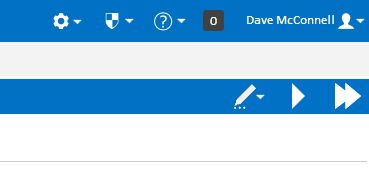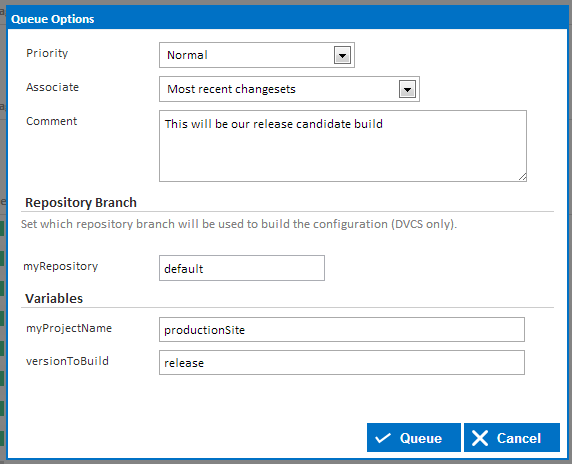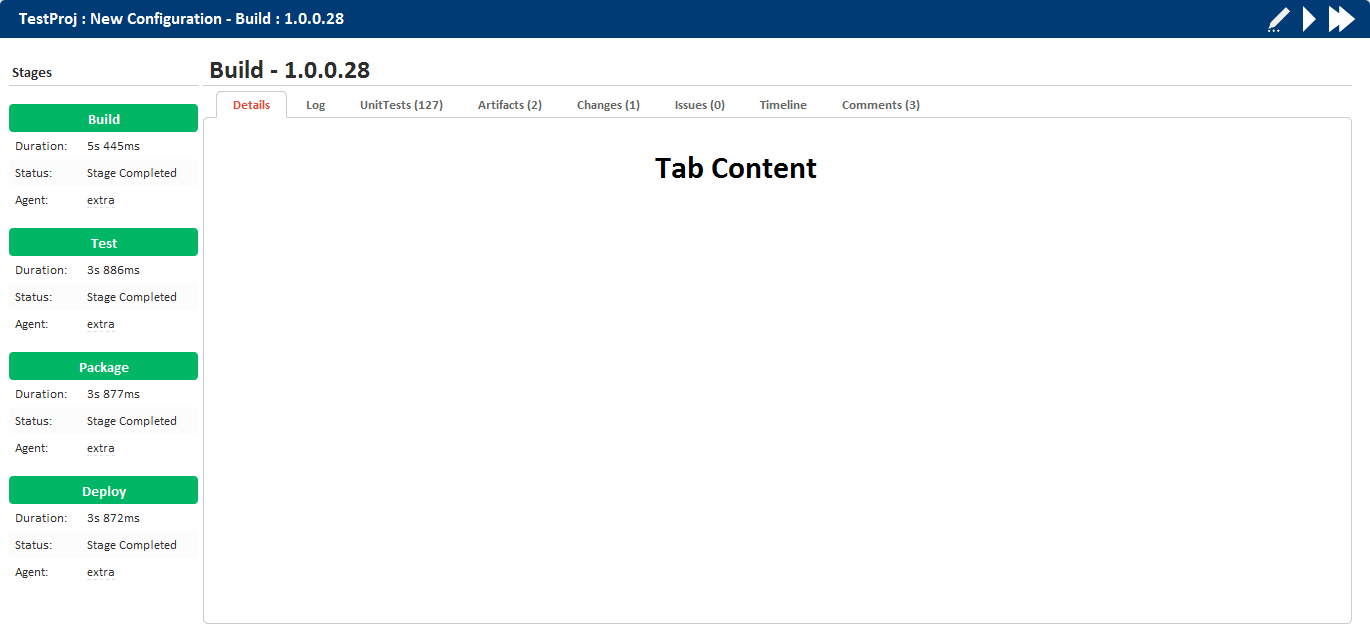What are Builds?
At the most basic level, builds are a set of actions that are executed sequentially to achieve a certain goal. Each build belongs to a configuration and the actions that run during the build are defined in a build's parent configuration. For example, a simple may include the following actions.
- Create an output folder in the agent workspace using the Create Directory Action.
- Build your project using the MSBuild Action and save the results into the output folder.
- Run Unit tests over your project using the NUnit Action.
Every build uses its parent configuration as a blueprint where everything relating to builds is defined on the configuration. You can think of a build as the execution of its parent configuration.
Builds can consist of multiple stages and each stage is executed on one of Continua's Agents. Before a stage is executed, the Continua server selects an agent to run the stage and sends all required information to the agent. This agent then runs all the actions on the stage before it sends any relevant information back to the server. For more information on how the server and agents work, check out the Distributed Architecture page.
Automatically Triggering Builds
Triggers can be created on a build's configuration that will automatically 'trigger' a build on certain events. Triggers can be broken up into 3 sections:
- Time Triggers: These triggers will fire a build on a specific day or at a specific time.
- Repository Triggers: These triggers are linked to your Version Control Systems (VCS) and they will fire a build when changes are detected in your VCS.
- Build Completed Triggers: These triggers will automatically start a build when another build has either finished successfully or failed.
Manually Starting Builds
Manual builds can also be queued at any time through the Continua CI interface. Builds can be manually started from any Configuration or Build page so choose which configuration should be built and navigate to that configuration. Once there you should see the Queue Build and Queue Build Immediately buttons in the Configuration Menu (As shown below).
Queue Build
Priority
This specifies the priority of the build. Priority determines which build to execute next if there are more builds queued than there are available agents. This can be set to either high, normal or low with high given the most priority.
Associate
This specifies which changesets should be associated with this build for all repositories on this build.
There are two options for Associate:
- Most recent changesets: This will only link the latest changeset for each repository to the build.
- All changesets since last successful build: This will add all the changesets that have occurred in all the repositories since the last successful build.
For example, let say my configuration is linked to a repository called myRepository. Since the last time a build was executed successfully, I have made the following checkins to the source code in myRepository:
- Fixed annoying deadlock bug. issue #3199.
- Minor UI fixes
- fixed show stopper bug #544
With these checkins, lets assume that Fixed annoying deadlock bug. issue #3199 is the latest checkin to be made.
What I have selected for Associate will change the latest changesets that I will see associated with my build.
For this example, once the build has finished running, if I check the latest changes made in myRepository, I will see the following checkins:
- With Associate set to 'Most recent changesets': Fixed annoying deadlock bug. issue #3199.
- With Associate set to 'All changesets since last successful build': Fixed annoying deadlock bug. issue #3199, Minor UI fixes, fixed show stopper bug #544.
Comment
Any comments added to this property will attach a comment to build.
Repository Branch
When queueing a build, you can specify which branch of your source code should be used when retrieving your repositories. Note that this only applies to Distributed Version Control Systems (DVCS) such as Git or Mercurial. The repository branch can be specified for each DVCS repository linked to the build.
Variables
Configuration variables that have been set on the build's parent configuration can have their values set when manually queueing a build. Note that only configuration variables can be set when queueing a build.
Queue Build Immediately
Clicking Queue Build Immediately button will queue a build in exactly the same way as the Queue Build button however all the build options (listed above) will be preset.
Queue Build Immediately will always set the following options:
- Build Priority: Normal
- Associate: Most recent changesets
- Comment: No comment set
- Repository Branch: All repository branches will be set to their default.
- Variables: All variables will be set to their default values.
The Build Queue
The Build Queue is where all builds wait until an agent becomes available that can run the next stage in the build. An agent is only eligible to run a stage if the agent has all the required applications installed so that it can execute every action on that stage.
Determining Build Bottlenecks
If there are multiple builds waiting for an agent, Continua will use the Build Priority property of the build to determine which build will be sent to the agent.
Queue Conditions
Queue Conditions can be created on a build's parent configuration which control when a build can leave the queue and begin executing. If a queue condition has not been met then the build will sit on the queue indefinitely until that queue condition has been met.
Stage Awaiting Agent
If you are frequently seeing builds waiting for available agents then there are more concurrent builds running then there are agents. By adding additional agents to Continua you should see a decrease in the number of builds that are waiting for an agent. Note that additional agents are only available to customers that have purchased additional concurrent builds for their Continua CI instance.
Stopping Builds
Quiet Periods
Promoting Stages
Tagging Builds
Pinning Builds
Every build in Continua can be viewed via the build's view. The builds view has the following simple format.
Stage Pane
The left pane shows a list of stages and their status, this pane constantly updates as the build progresses through its stages. Each stage name is clickable and takes you to the Build log's entry for that stage. The stage pane also shows you which agent the stage was executed on and will show a promote button if you've set that stage to manually promote.
Tab Pane
Each build has additional information you can view by switching to that tab. Here's a brief explanation of each tab.
Build Details - Shows a summary of the build, unit tests, changes, comments, tags and pinning.
Build Logs - A GUI for the build log. Lists each stage and action.
Unit Tests - If you've registered unit tests they'll be listed here in tabular format.
Artifacts - Any artifacts registered will be listed and viewable/downloadable here.
Changes - Changes to the Repositories linked with this Configuration and associated with the build.
Issues - If you've setup an Issue Connector, you'll see the issues extracted from your commit messages here.
Timeline - Lists every step of the build and a status message.
Comments - Lists all comments for the build.


